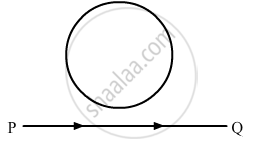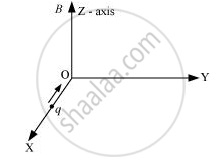Advertisements
Advertisements
प्रश्न
A conducting loop is held above a current carrying wire PQ as shown in the figure. Depict the direction of the current induced in the loop when the current in the wire PQ is constantly increasing.

उत्तर
The increasing magnetic field in the loop due to wire PQ is out of the plane of the paper (perpendicular to the plane). So, the direction of the induced current in the loop will be such that it produces an inward magnetic field (perpendicular to the plane). Thus, the current induced in the loop is in clockwise direction (using the right-hand thumb rule).
संबंधित प्रश्न
A long straight wire carries a current of 35 A. What is the magnitude of the field B at a point 20 cm from the wire?
A charge ‘q’ moving along the X- axis with a velocity `vecv` is subjected to a uniform magnetic field B along the Z-axis as it crosses the origin O.

(i) Trace its trajectory.
(ii) Does the charge gain kinetic energy as it enters the magnetic field? Justify your answer.
Explain "Magnetic force never does any work on moving charges".
An electron emitted by a heated cathode and accelerated through a potential difference of 2.0 kV, enters a region with uniform magnetic field of 0.15 T. Determine the trajectory of the electron if the field (a) is transverse to its initial velocity, (b) makes an angle of 30° with the initial velocity.
In SI system, permeability has the units ______.
A magnetic field exerts no force on
A charged particle would continue to move with a constant velocity in a region wherein ______.
- E = 0, B ≠ 0.
- E ≠ 0, B ≠ 0.
- E ≠ 0, B = 0.
- E = 0, B = 0.
A charge particle moves along circular path in a uniform magnetic field in a cyclotron. The kinetic energy of the charge particle increases to 4 times its initial value. What will be the ratio of new radius to the original radius of circular path of the charge particle:
A circular coil of wire is made up of 200 turns, each of radius 10 cm. If a current of 0.5A passes through it, what will be the Magnetic field at the centre of the coil?
Lorentz force in vector form is ______.
